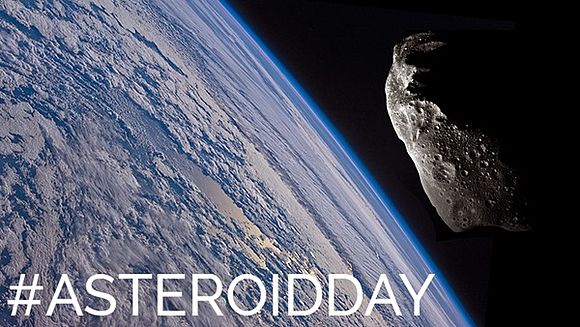Bremen, June 26, 2019. Asteroid Day was co-founded in 2014 by Dr. Brian May (astrophysicist and lead guitarist of QUEEN), together with Danica Remy (President of B612 Foundation), Rusty Schweickart (Apollo 9 Astronaut), and filmmaker Grig Richters. In 2016, the United Nations declared June 30 Asteroid Day, an international day of education. OHB has been a loyal supporter of Asteroid Day for a couple of years now.
We owe this to future generations
Widening our knowledge about asteroids is mandatory since, according to scientific evidence from researchers, an asteroid impact capable of causing major damage is to be statistically expected every few centuries. The more humanity knows about asteroids – starting with their localization and identification, including their trajectories and composition – the better humanity can prepare for day X, when an asteroid of potentially dangerous magnitude (i.e. with a diameter of more than 100 meters) heads towards our planet. About 1,000 new asteroids enter our planetary system each year. Nine hundred potentially hazardous Near Earth Objects are under surveillance. ESA’s first Flyeye telescope, developed and manufactured by OHB Italia, will support observations from Sicily, Italy in the near future.
Marco Fuchs, CEO of OHB SE, clearly sees the necessity for researching these celestial objects, which can pose a risk to humanity at any time, and is therefore contributing with his company’s own technical developments and investments: “We owe this to future generations”, says the entrepreneur and father of two. The tremendous progress that is being made in space technology paves the way for projects that are not only visionary but, like asteroid deflection missions, will also be of crucial importance to the protection of our planet. “I am an avid supporter of the planned asteroid mission HERA. We cannot miss this excellent opportunity to find out how asteroid deflection works and, at the same time, learn a lot more about asteroids. The missions DART and HERA which are planned by Nasa and ESA have the potential to lay a fundamental base. I am proud of the many bright minds at OHB and all over the world who work on concepts on how to protect mankind from asteroid impact”, adds Marco Fuchs.

Asteroid Day 2019 marks the program’s 5th anniversary
In commemoration of the 1908 Tunguska asteroid impact, Asteroid Day events are held around the world each year on 30 June for the general public. Asteroid Day is an ideal platform to generate public awareness of asteroids and their role in our solar system and for highlighting the need for science and technology to conduct asteroid research in order to create methods to protect us from asteroid impact and to facilitate future exploratory missions. Asteroid Day brings together academia, research and technology, space agencies, and the general public.
The topics addressed during Asteroid Day range from the role of asteroids in the formation of our universe, how asteroid resources can be used by mankind, how asteroid research can clear the path for future exploration and how we can protect planet Earth from asteroid impacts.
Asteroid Day is a program run by the Asteroid Foundation, a Luxembourg nonprofit organization. The amount of people united in their support of Asteroid Day is impressive, and underlines the global importance of asteroid research.
Asteroid Day 2019: Live from Luxembourg ...
As in recent years, there will once again be speakers from the OHB group in the live program from Luxembourg which will be transmitted live from Luxembourg on Friday June 28, 2019. All details are available on the Asteroid Day website.
... and as public events around the world
Events catering to all age groups will be held at science centers, planetariums, observatories, museums, schools, theaters, libraries, town congress halls and in public places all around the world. Most of the events are open to the general public and can be viewed on the Asteroid Day website.
Asteroids can cause damage even without direct surface impact
The largest ever asteroid impact in the recent history of mankind took place June 30, 1908. An area of around 2,000 square kilometers (comparable to a large metropolitan region) was devastated in Tunguska, Russia. Due to the fact that the asteroid hit the Earth in the remote Tunguska region in Siberia, there were no casualties.
The "Meteor of Chelyabinsk" caused serious damage in the megacity Chelyabinsk in the Urals and its surroundings on 15 February 2013. The comparatively small celestial object (diameter 15 to 20 meters) entered the Earth's atmosphere and broke apart 30 to 50 kilometers above the Earth. This caused an enormous blast wave that damaged around 7,000 buildings in the region. About 1,500 people were injured, some of them seriously; most suffered cuts and bruises from splintering glass and debris.
Contact for media representatives:
Marianne Radel
Head of Corporate Communications
Phone: +49 421 2020 9159
Email: marianne.radel@ohb.de
Contact for investors and analysts:
Marcel Dietz
Investor Relations
Phone: +49 421 2020 6426
Email: ir@ohb.de

